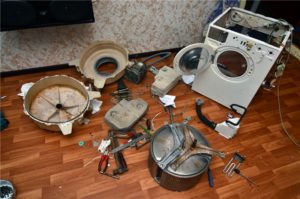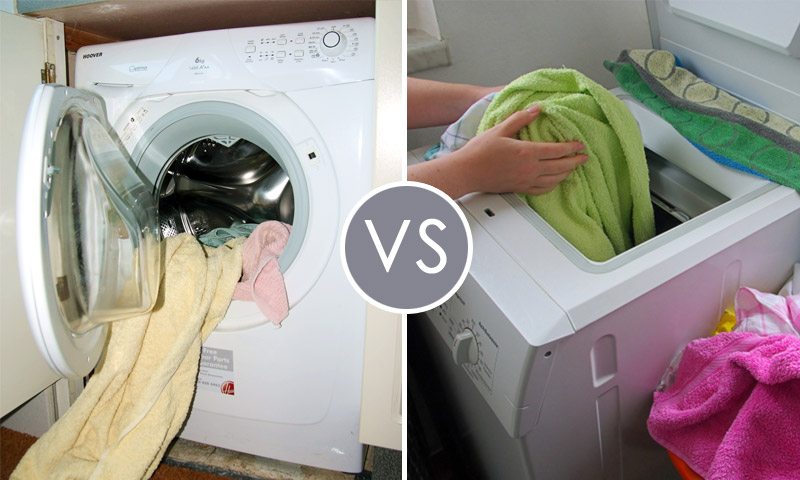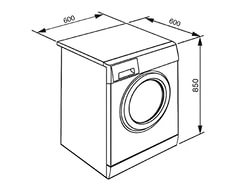Design of the Indesit washing machine
 Since almost all models of front-loading washing machines are practically the same, we will consider the internal structure of the washing machine using the example of an Indesit brand unit. Since today it is the leader in production and sales on the Russian market. So, let’s illustrate the structure of the Indesit washing machine.
Since almost all models of front-loading washing machines are practically the same, we will consider the internal structure of the washing machine using the example of an Indesit brand unit. Since today it is the leader in production and sales on the Russian market. So, let’s illustrate the structure of the Indesit washing machine.
Let's list the main elements
The washing machine device includes both main and additional modules. Your unit will only work if all components are in smooth contact with each other. A washing machine of any model contains:
- electric motor;

- tank and drum;
- drain pump;
- control panel with electrical module support;
- spring shock absorbers;
- special unit with bearings;
- the main body, the rear wall of which is made in the form of a hatch cover;
- liquid intake valve;
- tubular electric heater and parts for it.
Please note that this is a completely basic set of parts for any washing device. If you understand what and how the circuit works, you can easily analyze the behavior of your Indesit washing machine.
How does the technology work?
The Indesit washing machine is equipped with a plastic tank. To avoid deformation of the tank, it is not so rigidly connected to the body so that excessive vibrations are not created, which destroy the tank. After all, the tank moves very actively during washing and, especially, spinning, but the body remains motionless, which actually ensures the safety of the tank. Plus, two shock absorbers are placed below for support, and springs are placed on top.
During washing, the drum rotates thanks to a special pulley to which it is connected through a cross. The pulley, in turn, receives revolutions transmitted by the electric motor through a belt drive. All these actions cause the pulley to rotate, and since it is attached to the drum, the drum also rotates, due to which our clothes are washed. The drum itself is built inside the tank with a mount.
The so-called “intelligence center” of the washing machine is the control board; it is it that sets the sequence of operations and the coordinated interaction of all components of the unit. For example, supplying a washing machine with water includes a number of actions of different parts: the inlet valve draws water from the water supply, the heating element heats it to the required temperature, the pressure switch controls the volume of water, and a special pump removes contaminated water after the washing process is completed.
Now you can roughly imagine how your washing machine works and how it works, but to add more details, you should look at the operation of each module separately.
Main container and drum
Drums are predominantly made of stainless steel, as are the tubs of some washing machines. This material is more durable and, as a result, your machine will last much longer. However, if you prefer a more budget-friendly and lightweight option, take a machine with a plastic tank. It is not as durable, but it is cheaper and easier to carry. In the most common models, the tank is located horizontally, although some manufacturers also produce machines with inclined tanks.
All modern Indesit washing machines are equipped with plastic tanks.
So, the tank is the main capacity of any washing machine.As we already understood, there is a built-in drum into which you load your laundry. The drum usually has a huge number of holes through which water from the tank penetrates into this container. Yes, water is drawn from the water supply into the tank, where it is heated and mixed with the powder, and enters the drum during the washing process. In addition, the surface of the metal tank is very corrugated, which improves the quality of washing. To avoid leaks and other troubles, no foreign objects should get into the tank.
Heating the mixture of water and powder
 A tubular electric heater, or abbreviated as a heating element, which is built into the lower part of the machine, is responsible for heating the water in the tank. When the washing machine is actively used, the heating element is subject to the greatest damage, because scale forms on its surface, which gradually disables it, and, in addition, the heating elements always fail faster than other electrical appliances. The more often you wash in hot water, the faster problems will arise with the heater.
A tubular electric heater, or abbreviated as a heating element, which is built into the lower part of the machine, is responsible for heating the water in the tank. When the washing machine is actively used, the heating element is subject to the greatest damage, because scale forms on its surface, which gradually disables it, and, in addition, the heating elements always fail faster than other electrical appliances. The more often you wash in hot water, the faster problems will arise with the heater.
According to the technical characteristics, it is worth saying that the energy consumption is approximately 1800-2200 W. This is equal to the average energy consumption of any heating mechanism. Therefore, if it seems to you that the washing machine “eats” a lot of energy, then the problem is clearly with the heating element.
What makes the drum move?
Remember we already talked about the connection between the drum, pulley and electric motor? It is the electric motor that powers the device. Indesit uses commutator motors in order to save money and, as a result, to reduce the cost of goods. However, commutator motors do not have any enviable strength, and in addition, they are very susceptible to voltage drops, so it is better to connect them through a stabilizer.
Brushed motors quickly lose their level of functionality, and eventually stop working altogether if they are not carefully maintained (you will have to, for example, change the brushes regularly).
Water supply and removal
Water is supplied from the water supply to the tank according to this scheme.
- A specialized module “orders” the intake valve to open;
- The valve opens, and since it is under high pressure, water immediately begins to penetrate into the tank.
- The pressure switch controls the volume of water so that exactly as much as is needed (the same happens when draining water, so this sensor is indispensable for any machine);
- When the required volume has been reached, the pressure switch signals the module, and it, in turn, signals the valve that there is enough water and needs to close.
- The valve closes and the water supply stops.
As soon as the wash is completed, the control module begins to interact with the pump. The pump receives a signal to drain water and begins to push it into the sewer through the drain hose. Thus, water is pumped out from the tank. Then, using the same operations, the machine draws in water to rinse the laundry, and then drains it in the same way.
The “brain” of the washer
 The control board is responsible for all parts of the machine, except for the control panel (it includes all the buttons, indicators, etc.). There is a separate fee for this. Both of these devices are combined and perform the function of the “intelligence” of the machine: they issue commands to the modules for the coordinated operation of the device.
The control board is responsible for all parts of the machine, except for the control panel (it includes all the buttons, indicators, etc.). There is a separate fee for this. Both of these devices are combined and perform the function of the “intelligence” of the machine: they issue commands to the modules for the coordinated operation of the device.
Washing programs and modes are pre-designed algorithms for certain actions that are recorded on the control board. Accordingly, it is responsible for the operation of any program that you choose. The board structure consists of many semiconductor elements (these include triacs, thyristors and other parts).
Contacts between parts are made through special electrically conductive tracks, which are also located on the control board.
The control panel board has a slightly different purpose. While the control board coordinates the interaction of parts, this one coordinates the interaction between the operator and the control board. That is, its task is to “explain” to the control board what exactly the user wants to do, as well as inform him about all the details of the wash (by displaying information on a special screen or through indicators).
Auxiliary elements
We have figured out how the basic parts of the Indesit washing machine work. However, there are many more. Their role is not so fundamental, but without them your washing will not happen either. Here is their list.
- Parts that prevent the harmful effects of vibration on the tank are springs and shock absorbers. They dampen vibration.
- To prevent water from flowing out from under the hatch cover, there is a special cuff. This is a kind of rubber seal that tightly seals the hatch when washing.

- Hatch blocking device - abbreviated as UBL. This detail also helps to completely close the hatch and prevent accidental or independent opening. As long as the UBL is in good working order, water will not pour out of the machine.
- Drive belt.The one that directs the rotation to the pulley, and the pulley, as you remember, helps rotate the drum. Therefore, for the drum to operate, you cannot do without this part.
- Counterweights. Counterweights are very large stones, both in volume and weight, that are installed inside the body, increasing its mass. Due to these parts, the machine has the ability to resist centrifugal force during spinning. Otherwise, the washing machine would move very actively around the room due to pressure on the side walls.
- Hatch door. There is no need to describe the significance of this detail. Without it, washing is basically impossible.
- Powder receiver. There you place detergent and conditioner, which are dosed into the tank during the washing process. As a rule, it includes three compartments for different types of detergents.
- Pipes. Through them, water moves into and out of the tank. Built into the body.
Now, knowing all the details of the operation of the Indesit washing machine and the features of its design, you can easily analyze its behavior and condition. If a problem occurs, you will know what to look for first, and you will probably be able to carry out simple repairs yourself. Remember that if you treat it with care, your device will last you much longer and will delight you with its quality much more.
Interesting:
Reader comments
- Share your opinion - leave a comment





















Add a comment